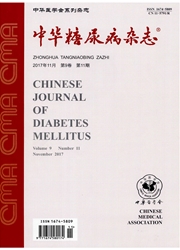

 中文摘要:
中文摘要:
目的探讨利拉鲁肽对db/db小鼠胰腺及大鼠胰岛细胞瘤细胞系INS-1中microRNA表达的影响。方法将20只4周龄雄性db/db小鼠按随机数字表法分为对照组和利拉鲁肽组(每组10只)。分别给予0.1ml生理盐水或300ng/g利拉鲁肽皮下注射,每E12次。8周后测定糖化血红蛋白,行腹腔注射葡萄糖耐量试验(TPGTT)。8周末处死小鼠,免疫组化法分析小鼠胰腺B细胞增殖水平;实时荧光定量聚合酶链反应(RT-PCR)测定小鼠胰腺microRNA(miR.375和miR-34a)的表达。INS-1细胞分别给予0.5mmol/L棕榈酸培养0、48、72h或100nmol/L利拉鲁肽预处理12h后,给予0.5mmol/L棕榈酸培养72h,RT—PCR测定miR-375和miR-34a表达水平。采用t检验及方差分析进行组间数据比较分析。结果与对照组相比,利拉鲁肽组小鼠糖化血红蛋白水平降低(分别为7.3%±0.3%和4.7%±0.6%,t=16.47,P〈0.01);IPGTT血糖曲线下面积降低[分别为(4568-4-197)和(1927±127)mmol·L-1·min-1,t=26.53,P〈0.05];胰岛素曲线下面积增加[分别为(1080±247)和(2818±378)μg·L-1·min-1,t=7.73,P〈0.05]。免疫组化法显示,与对照组相比,利拉鲁肽组小鼠胰岛素阳性面积增加(分别为1.40±0.30和0.37±0.09,t=19.14,P〈0.01),Brdu染色阳性细胞比例增加(分别为2.40%±0.22%和0.73%±0.10%,t=4.97,P〈0.01)。利拉鲁肽组小鼠胰腺miR-375与miR-34a表达较对照组分别降低50%(分别为1.1±0.3和2.2±0.5,t=3.08,P〈0.05)和71%(分别为1.1±0.3和3.8±1.2,t=2.80,P〈0.05)。棕榈酸培养使INS-1细胞miR-375表达呈剂量、时间依赖性增加,利拉鲁肽可抑制棕榈酸诱导的miR-375表达(F=7.20,P〈0.01)。结论microRNA可能是利拉鲁肽调节β细胞增殖的靶点之-。
 英文摘要:
英文摘要:
Objective To investigate the effect of glucagon-like peptide 1 analogue liraglutide on microRNA expression of db/db mice and rat insulinoma cell line ( INS-1 ). Methods Twenty 4-week old male db/db mice were randomly assigned to receive a subcutaneous injection of liraglutide (300 ng/g bid)or normal saline (0. 1 ml bid) ( control group) according to random numbers table. Glycated hemoglobin (HbAlc) was determined before and after 8 weeks of intervention. At the end of the intervention, intraperitoneal glucose tolerance test (IPGTT) was performed. Beta cells proliferation rate was determined by using immunohistochemistry methods. INS-1 cells were cultured with 0. 5 mmol/L palmitic acid for 0, 48, 72 h or treated by 100 nmol/L liraglutide for 12 h before 72 h of palmitic acid(0. 5 mmol/L) culture. microRNA miR-375 and miR-34a expression were examined by real-time polymerase chain reaction (RT- PCR). The t test or ANOVA analysis was used for data analysis. Results Compared with the control group, HbAlc in the liraglutide group was significantly lower (7.3% ± 0. 3% vs 4. 7%± 0. 6%, t = 16.47, P 〈 0. 01 ); the glucose aera under curve in the liraglutide group was decreased significantly ((4568±197) vs (1927 ±127) mmol · L-1· min-1, t =26.53, P 〈0.05) , while insulin aera under curve was increased significantly ( (1080 ±247) vs(2818±378) μg· L-1· min-1, t =7. 73,P 〈0. 05). Immunohistochemistry showed more insulin staining in single pancreas of db/db mice after liraglutide treatment than in the control group ( 1.40 ±0. 30 vs 0. 37±0. 09 ,t = 19. 14, P 〈0. 01 ). More Brdu-positive cells were observed in islets of liraglutide-treated mice than in control mice after intervention (2.40%± 0. 22% vs 0. 73% ± 0. 10% ,t = 4. 97, P 〈 0.01 ). Compared with control mice, the miR-375 expression of pancreas in liraglutide-treated db/db mice was reduced by 50% ( 1.1 ± 0. 3 vs 2. 2 ±0. 5, t = 3.08, P 〈 0.05 ) and miR-34a was reduced by
 同期刊论文项目
同期刊论文项目
 同项目期刊论文
同项目期刊论文
 期刊信息
期刊信息
